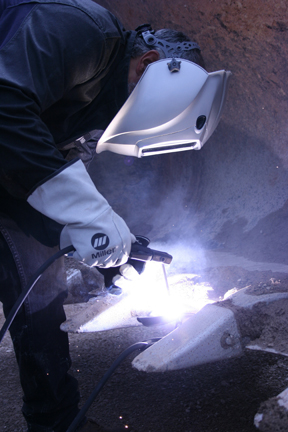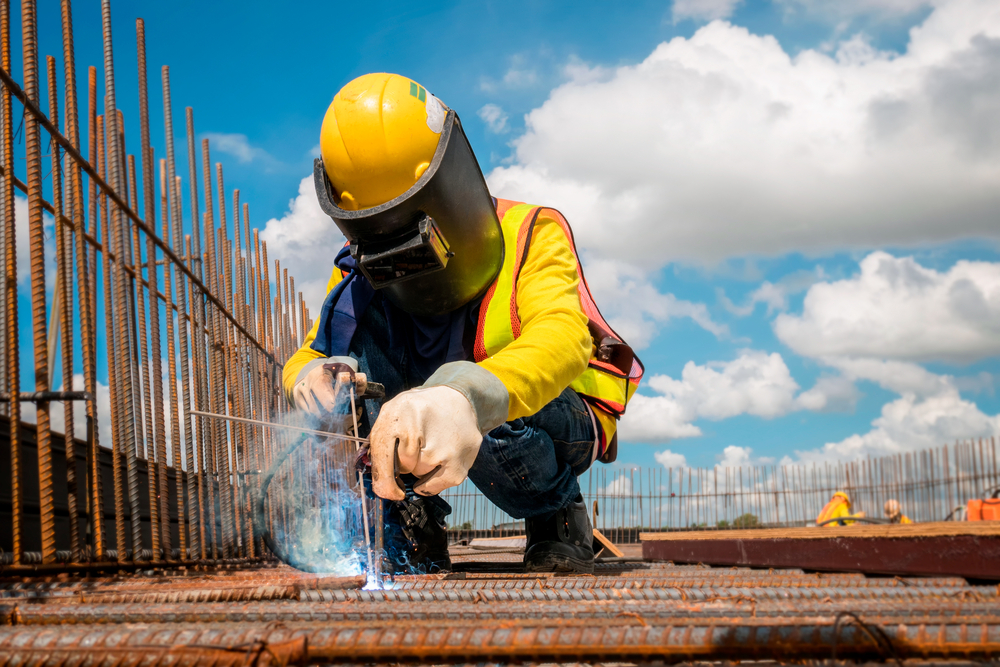Usual Welding Repair Issues and How to Address Them Properly
Welding repair work typically run into a variety of problems that can endanger the integrity of the final item. Usual issues consist of insufficient infiltration, porosity, and misalignment, amongst others. Each flaw provides special obstacles that call for particular approaches for resolution. Understanding these problems is important for welders aiming to boost their skills and results. This conversation will certainly check out these usual welding repair service concerns and efficient approaches to address them.
Insufficient Infiltration
Poor penetration occurs when the weld metal fails to completely fuse with the base product, leading to weak joints and possible architectural failings. This problem frequently originates from not enough heat input, wrong electrode angle, or inappropriate welding speed. Welders may experience inadequate penetration because of a miscalculation of the needed criteria for a details product density or type. Furthermore, contamination on the base material's surface area can hinder reliable bonding, aggravating the trouble. To deal with insufficient penetration, welders must ensure appropriate setups on their devices and keep a tidy job surface area. Routine examination of welds is recommended to identify any shortages early, allowing for prompt adjustments and the avoidance of compromised architectural integrity in bonded settings up.
Porosity
Porosity is a common flaw in bonded joints that materializes as tiny gas bubbles entraped within the weld metal. This problem can compromise the stability of the weld, bring about minimized strength and prospective failure under anxiety. Montana Mobile Welding and Repair Belgrade Fabrication. Porosity usually develops from contamination, dampness, or incorrect welding methods, which allow gases to get away right into the liquified weld pool. To attend to porosity, welders ought to guarantee appropriate surface preparation, preserve a tidy workplace, and make use of appropriate welding parameters. In addition, choosing the right filler product and shielding gas can minimize gas entrapment. Routine evaluation and testing of welds can assist recognize porosity early, ensuring prompt restorative activities are taken, thus maintaining the high quality and dependability of the welded framework
Imbalance
Misalignment in welding can arise from different factors, including inappropriate configuration and thermal expansion. Comprehending the source is crucial for reliable resolution. Numerous adjustment strategies are available to realign components and ensure structural honesty.
Sources of Imbalance
Welding misalignment commonly stems from a range of underlying issues that can endanger structural honesty. One primary cause is inappropriate fit-up of elements before welding, which can result in spaces and unequal surface areas. Variations in thermal development during the welding process can also lead to distortion, particularly if the products being signed up with have various coefficients of growth. Additionally, insufficient clamping and fixturing may fall short to hold elements safely in place, resulting in movement during welding. Improperly maintained equipment, consisting of welding machines and tools, might present inconsistencies in the weld bead, additional contributing to misalignment. Finally, driver mistake, coming from inadequate training or experience, can also play a considerable role in developing misaligned welds.
Improvement Techniques Offered
Addressing imbalance effectively calls for a combination of corrective techniques tailored to the certain issues available. One usual approach is the usage of fixtures or jigs to hold components in the proper placement throughout welding, ensuring regular positioning. Furthermore, preheating the products can help reduce distortion and boost fit-up. For substantial misalignment, mechanical adjustment strategies, such as using hydraulic jacks or clamps, can be employed to remedy the position prior to welding. Post-weld heat treatment might also be essential to soothe tensions brought on by imbalance. Careful examination and change throughout the configuration stage can protect against imbalance problems from becoming considerable problems, promoting a smoother welding process and boosting general structural stability.
Distortion
Distortion is a typical obstacle in welding that can emerge from numerous variables, consisting of irregular cooling and heating. Recognizing the reasons of distortion is crucial for carrying out efficient prevention strategies. Resolving this problem not just boosts structural honesty but likewise improves the general high quality of the weld.
Reasons of Distortion
When based on the extreme heat of welding, materials frequently go through changes that can result in distortion. This phenomenon primarily emerges from thermal development and tightening throughout the welding procedure. As the weld area heats up, the material broadens; upon cooling, it contracts, which can create interior stresses. Additionally, uneven heating throughout a workpiece can exacerbate these tensions, causing bending or flexing. The type of material likewise plays a substantial role; steels with varying thermal conductivity and coefficients of growth may respond in different ways, causing unforeseeable distortions. Moreover, poor joint style and poor fixturing can add to misalignment throughout welding, enhancing the chance of distortion. Understanding these causes is important for reliable welding repair service and prevention methods.
Prevention Techniques
Efficient prevention strategies for distortion during welding concentrate on regulating warm input and making sure correct joint layout. Keeping a consistent warm input aids to lessen thermal development and tightening, which can result in distortion. Using strategies such as pre-heating the work surface can additionally lower the temperature slope, advertising consistent heating. Furthermore, choosing suitable joint styles, such as T-joints or lap joints, can improve stability and decrease stress and anxiety focus. Executing proper fixturing to protect the work surfaces in position further help in preserving positioning throughout the welding process. Ultimately, staggered welding sequences can disperse warmth more uniformly, protecting against localized distortion. By using these methods, welders can greatly reduce the possibility of distortion and improve the general quality of their welds.
Splitting
Fracturing is a common concern encountered in welding repairs, usually resulting from various factors such as improper cooling rates, product option, or insufficient joint prep work. The event of fractures can considerably jeopardize the integrity of the weld, causing prospective failures throughout procedure. To address this problem, welders need to initially analyze the root creates, guaranteeing that products work and properly chosen for the specific application. Furthermore, controlling the cooling price throughout the welding procedure is essential; quick cooling can induce stress and anxiety and lead to universal welding wire breaking. Correct joint layout and preparation also add to reducing the threat. Carrying out these techniques can boost weld quality and resilience, ultimately decreasing the possibility of breaking in completed weldments.

Insufficient Fusion
A considerable issue in welding repairs is insufficient combination, which occurs when the weld metal does not adequately bond with the base material or previous weld passes - Montana Mobile Welding and Repair Fabrication. This problem can result in weak points in the joint, potentially compromising the integrity of the bonded structure. Aspects adding to incomplete fusion consist of not enough warm input, inappropriate welding technique, and contamination of the surface areas being joined. To resolve this issue successfully, welders must ensure correct pre-weld cleansing and surface prep work, as well as readjust their welding specifications to attain sufficient infiltration and fusion. Normal examination throughout the welding procedure can likewise aid identify incomplete fusion early, enabling timely rehabilitative measures to improve the general quality of the weld
Overheating
While welding fixings can boost architectural integrity, overheating provides a considerable difficulty that can result in material deterioration. Too much warmth throughout welding can change the mechanical properties of metals, resulting in minimized toughness, boosted brittleness, and warping. This phenomenon is specifically critical in high-stress applications where structural integrity is vital. Recognizing getting too hot can include visual assessments for staining or distortion, in addition to keeping an eye on temperature level during the welding process. To mitigate the risks connected with getting too hot, welders need to employ proper methods, such as regulating heat input, readjusting travel rate, and utilizing appropriate filler products. Additionally, applying pre- and post-weld warmth treatments can aid bring back product residential properties and enhance the overall quality of the repair service, making sure long-lasting efficiency and safety and security.
Regularly Asked Concerns
What Are the Usual Indicators of a Welding Issue?

How Can I Test My Welds for High quality?
To evaluate welds for top quality, one can make use of aesthetic assessments, ultrasonic screening, and radiographic techniques. Each technique assures structural honesty, determines flaws, and confirms adherence to defined criteria, eventually improving the integrity of the bonded joints.
What Security Precautions Should I Take While Welding?
When welding, one must prioritize safety by using proper personal protective equipment, making sure correct ventilation, securing have a peek at these guys combustible materials away, keeping a tidy workspace, and recognizing surroundings to avoid accidents and injuries.
Can I Fix a Weld Without Redesigning the Entire Joint?
Fixing a weld without remodeling the whole joint is possible, depending on the damage (Montana Mobile Welding and Repair Fabrication). Methods such as grinding, adding filler product, or using a welding process can successfully resolve specific defects while preserving the surrounding structure
What Tools Are Vital for Effective Welding Repair Works?
Essential tools for reliable welding repairs consist of a welding machine, cord brush, mill, safety equipment, clamps, and filler materials. Each tool plays a crucial duty in making sure quality and safety and security during the fixing procedure. Porosity generally develops from contamination, wetness, or improper welding strategies, which permit gases to run away right into the liquified weld swimming pool. Improperly maintained devices, consisting of welding devices and devices, may present incongruities you can try this out in the weld bead, additional contributing to imbalance. When subjected to the extreme warm of welding, materials usually go through changes that can lead to distortion. Fracturing is an usual concern run into in welding repair work, commonly resulting from numerous factors such as inappropriate air conditioning prices, product option, or insufficient joint prep work. A substantial issue in welding fixings is incomplete fusion, which occurs when the weld metal does not properly bond with the base material or previous weld passes.